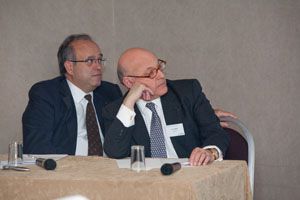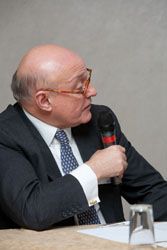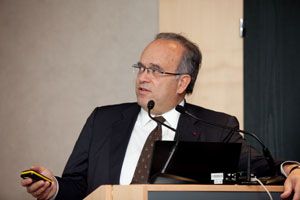Connecting Physicians: Strengthening the Oncology Network
Changes in the field of oncology in the last twenty years have led to complex networks between physicians. Doug Kitson reports on how Cegedim's Physician Connect Oncology aims to optimize these.
Changes in the field of oncology in the last twenty years have led to complex networks between physicians. Dramatic increases in competition, prices and the number of products on the market have moved the models away from a select club of key opinion leaders towards a massive network; increased in size, but more specialized. To understand these networks Cegedim has produced Physician Connect Oncology, a nominative database profiling physicians and their networks.
Twenty years ago there was one leading hormonotherapy product, and no more than five leading families of chemotherapy products, the costs of which was low compared to today. In this landscape, only a few people stood out as the main opinion leaders. They were making the decisions in clinical development strategies, influencing the registration process and leading the positioning and usage of drugs; but this group was made up of a very small number of individuals.
Throughout the 1990s, the number of products grew, prices increased ten-fold and the field of oncology became an attractive therapeutic field for pharmaceutical and biological companies to expand into.
With the emergence of biologics and targeted therapies, there are now more than 700 compounds under clinical development. Opinion leaders still play a role in defining clinical development strategies, advise regulatory agencies and participate in life cycle management, through scientific advisory boards. Their numbers have increased, but the individual's reach within their network has shrunk - more influencers are focused within oncology rather than working on the field as a whole, and their role internationally has diminished, leaving more leaders with mainly national or local impact.

To understand the modern oncology market, Cegedim determined that it was key to find how these doctors and institutions are connected, and how these networks can be influenced. This also required them to find on who or want these doctors rely on, and how they make their decisions.
Traditionally, opinion leaders are identified with a top-down methodology, looking at them from a scientific standpoint; identifying how much they publish, or asking a other leaders. However, this provides a limited view of who the physician actually is and how they fit into the overall network.

Instead, Physician Connect takes a bottom-up approach, interviewing physicians and profiling them through their responses, identifying and defining their network links at local, national and international levels. Physicians were sent a questionnaire, by which they provide detailed information on the kinds of cancer they treat, as well as some of their attitudes toward treatment and colleagues and other doctors who influence them. So far the company has questioned over 14,000 respondents and claims to have identified more than 24,000 experts and approximately 100,000 links between physicians. These respondents cover 12 oncology sub-specialities and come from nine countries, seven European, as well as the US and Canada.

In the field of breast cancer, the company picked out the top ten international influencers and presented this data to a panel of experts, whose responses were mixed; many they agreed with, but there were some they thought did not belong and others they thought were missing. In response, Alain Herrera, who presented the data on behalf of the company said that, to some extent, this is to be expected: "People who are, scientifically speaking, contributing the most to the advances in the field of breast cancer, are not mentioned, and you have oncologists who continue to rely on people who were key in this field 20-30 years ago, but not any more. So I think you have to consider, when you look at the data, that this is reflecting the real life of the community of oncologists."
As well as providing data on the physicians networks, the questionnaire also gathered profile information on the physicians themselves. A high proportion of German responders considered themselves to be early adopters for new drugs and techniques, while a significantly higher percentage of Italians were embracing online education, compared with other EU5 respondents.

Compared with other European countries, France has a large proportion of oncologists involved in clinical trials, but a low percentage with presentations in international events or work published internationally. Commenting on this difference, Professor David Khayat, Pitié-Salptrire Hospital, Paris said, "It reflects, absolutely the origin on papers published in the Journal of Clinical Oncology, of which I am editor. When we looked for the geographic origin of papers that have been submitted or accepted, France is very far behind. Spain and Italy are very much in front of us. This reflects the true situation that there are few real international key opinion leaders in France, and therefore few [principal investigators] PIs for big clinical trials and therefore, few authors of the papers coming from these trials."
Also highlighted was a strong emphasis on drug acquisition cost as a deciding factor of treatment in the UK. Professor Peter Harper, Consultant Medical Oncologist at the London Oncology Clinic discussed: "We are driven by the national institute for clinical excellence (NICE), which also has in its title, which no one mentions, 'and cost-effectiveness'. The model that they use, many of us feel is grossly out dated and irrelevant in the modern age and we've seen the only drug available, for instance for the treatment of metastatic kidney cancer, take far longer to get through NICE than it should have done. So we see cost driving everything, not excellence, not quality, not need. Despite that we now no longer have, what I would call a cheap health service, over the last 12 years our health service has doubled in price and is now the equivalent of any European cost. So we've gone up but we still don't have access to the drugs. Professor Khayat had Herceptin available for the relevant breast cancer patients within six weeks of the first publication; we took 18 months."

However in France, the cost of drugs was largely unimportant. "I'm not that surprised," said Professor Khayat. "I'm not sure that many oncologists in France would really know the cost of the drugs they are using, because it's not on the box. Most of them are using drugs just by prescribing with not idea how much they cost."
Looking at how people prefer to receive the latest information on the pathology and the treatment, close to 60% of Italian respondents declared that online is their preferred medium, showing a much higher level of comfort with this technology than in German or France, who were much less interested.
In conclusion, Professor Herrera said that Physician Connect provides an interesting tool understand the networks of oncologists. It provides a detailed picture that could help players adapt and react to the field around them.
"I think that the more people know of what you're doing, the more responses you'll get and I think it will become quite a significant player," said Professor Harper. Although there are currently thousands of responses, Professor Harper said there many still be many more to come from some of the busier leaders.
"As you said it is a little baby, just a newborn, but it will grow and become better, and better," commented Professor Khayat. "I am sure that at the end of the day it will become something very important."